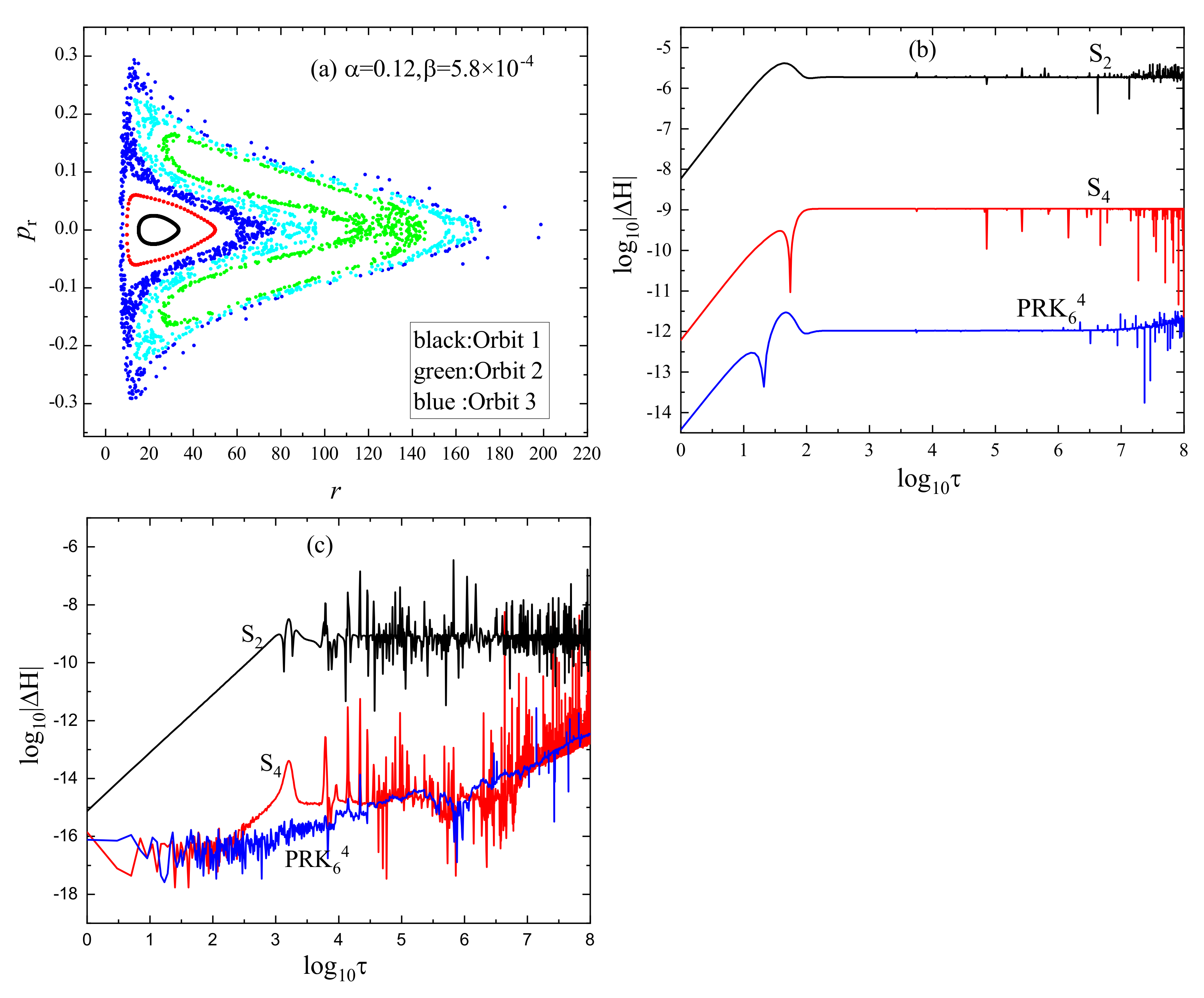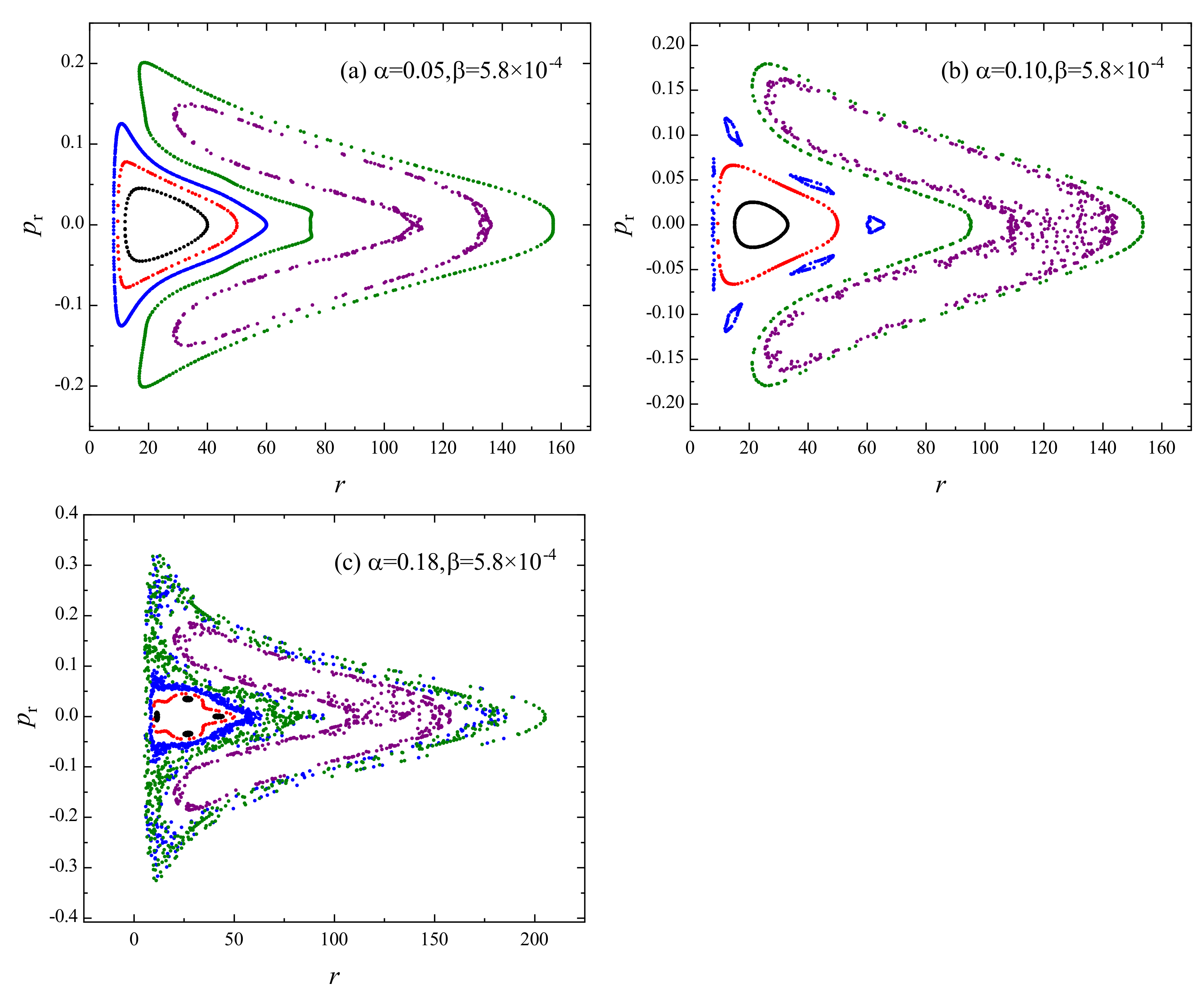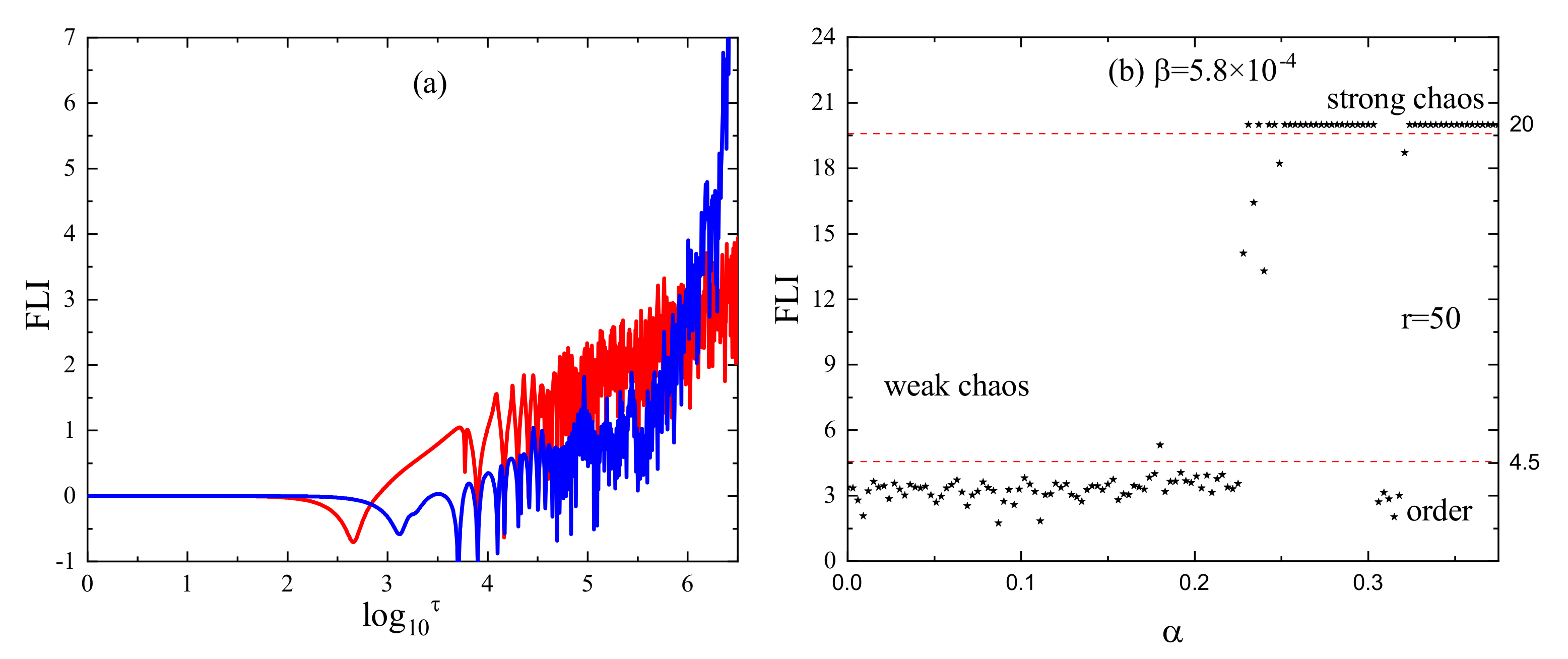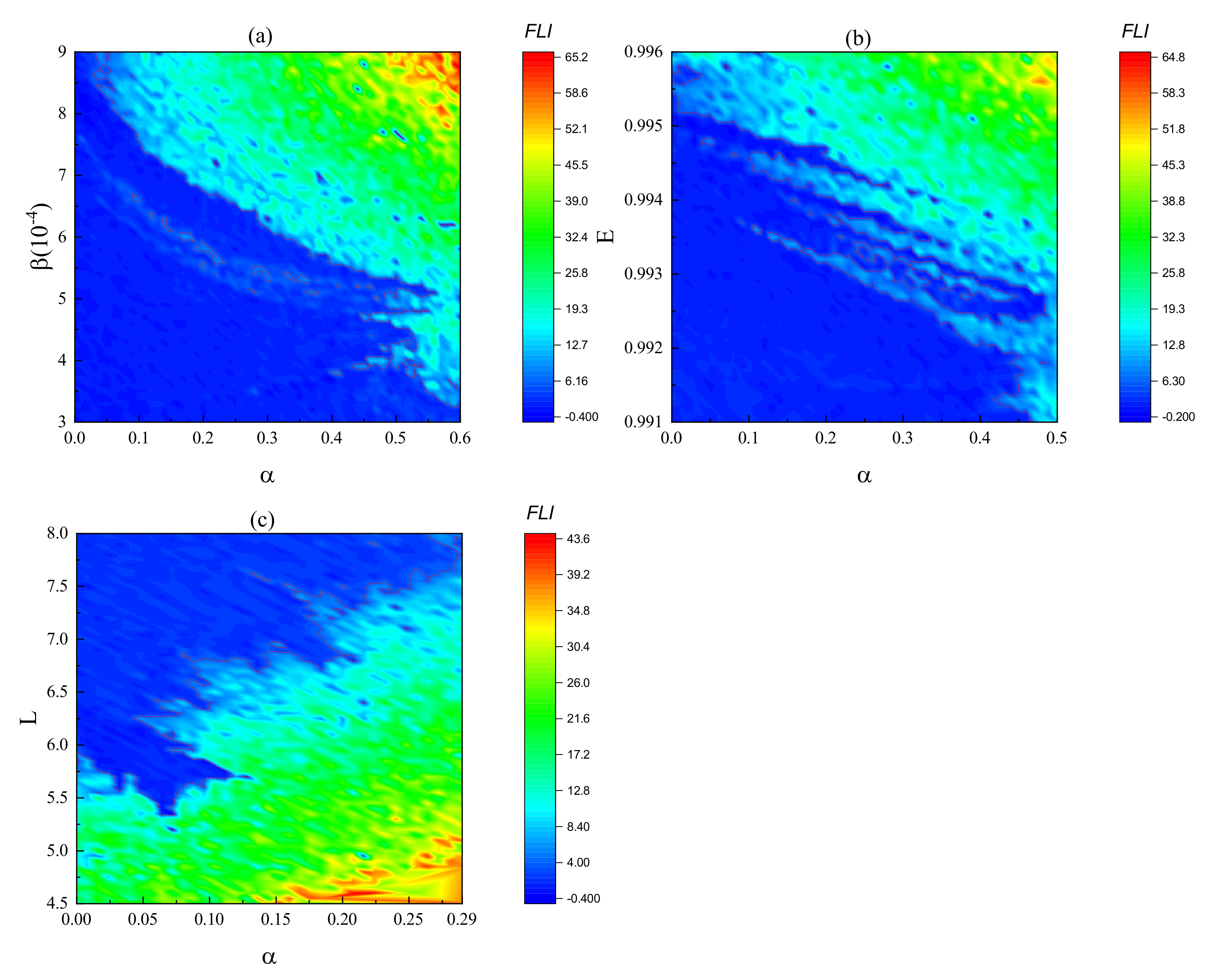Chaos in a Magnetized Modified Gravity Schwarzschild Spacetime
Abstract
:1. Introduction
2. Modified Gravity Nonrotating Black Hole Immersed in an External Magnetic Field
3. Numerical Investigations
3.1. Construction of Explicit Symplectic Methods
3.2. Orbital Dynamical Behavior
4. Conclusions
Author Contributions
Funding
Institutional Review Board Statement
Informed Consent Statement
Data Availability Statement
Acknowledgments
Conflicts of Interest
References
- Abbott, B.P.; Abbott, R.; Abbott, T.D.; Abernathy, M.R.; Acernese, F.; Ackley, K.; Adams, C.; Adams, T.; Addesso, P.; Adhikari, R.X.; et al. Observation of Gravitational Waves from a Binary Black Hole Merger. Phys. Rev. Lett. 2016, 116, 061102. [Google Scholar] [CrossRef]
- Abbott, R.; Abbott, T.D.; Abraham, S.; Acernese, F.; Ackley, K.; Adams, C.; Adhikari, R.X.; Adya, V.B.; Affeldt, C.; Agathos, M.; et al. Properties and Astrophysical Implications of the 150 M⊙ Binary Black Hole Merger GW190521. Astrophys. J. Lett. 2020, 900, L13. [Google Scholar] [CrossRef]
- The Event Horizon Telescope Collaboration; Akiyama, K.; Alberdi, A.; Alef, W.; Asada, K.; Azulay, R.; Baczko, A.-K.; Ball, D.; Baloković, M. First M87 Event Horizon Telescope Results. I. The Shadow of the Supermassive Black Hole. Astrophys. Lett. 2019, 875, L1. [Google Scholar] [CrossRef]
- Clifton, T.; Ferreira, P.F.; Padilla, A.; Skordis, C. Modified gravity and cosmology. Phys. Rep. 2012, 513, 1–189. [Google Scholar] [CrossRef] [Green Version]
- Russo, J.G.; Tseytlin, A.A. Scalar-tensor quantum gravity in two dimensions. Nucl. Phys. B 1992, 382, 259–275. [Google Scholar] [CrossRef] [Green Version]
- Deng, X.-M. Geodesics and periodic orbits around quantum-corrected black holes. Phys. Dark Universe 2020, 30, 100629. [Google Scholar] [CrossRef]
- Deng, X.-M. Periodic orbits around brane-world black holes. Eur. Phys. J. C 2020, 80, 489. [Google Scholar] [CrossRef]
- Zhou, T.-Y.; Xie, Y. Precessing and periodic motions around a black-bounce/traversable wormhole. Eur. Phys. J. C 2020, 80, 1070. [Google Scholar] [CrossRef]
- Zhang, J.; Xie, Y. Probing a self-complete and Generalized-Uncertainty-Principle black hole with precessing and periodic motion. Astrophys. Space Sci. 2022, 367, 17. [Google Scholar] [CrossRef]
- Strominger, A.; Trivedi, S.P. Information consumption by Reissner-Nordström black holes. Phys. Rev. D 1993, 48, 5778–5783. [Google Scholar] [CrossRef] [Green Version]
- Kazakov, D.I.; Solodukhin, S.N. On quantum deformation of the Schwarzschild solution. Nucl. Phys. B 1994, 429, 153–176. [Google Scholar] [CrossRef] [Green Version]
- Lin, H.-Y.; Deng, X.-M. Rational orbits around 4D Einstein-Lovelock black holes. Phys. Dark Universe 2021, 31, 100745. [Google Scholar] [CrossRef]
- Gao, B.; Deng, X.-M. Dynamics of charged test particles around quantum-corrected Schwarzschild black holes. Eur. Phys. J. C 2021, 81, 983. [Google Scholar] [CrossRef]
- Lin, H.-Y.; Deng, X.-M. Precessing and periodic orbits around Lee-Wick Black holes. Eur. Phys. J. Plus 2022, 137, 176. [Google Scholar] [CrossRef]
- Lin, H.-Y.; Deng, X.-M. Bound orbits and epicyclic motions around renormalization group improved Schwarzschild black holes. Universe 2022, 8, 278. [Google Scholar] [CrossRef]
- Nordstrom, G. On the possibility of unifying the electromagnetic and the gravitational fields. Phys. Z. 1914, 15, 504–506. [Google Scholar]
- Deng, X.-M.; Xie, Y. Improved upper bounds on Kaluza-Klein gravity with current Solar System experiments and observations. Eur. Phys. J. C 2015, 75, 539. [Google Scholar] [CrossRef] [Green Version]
- Bergmann, P.G. Comments on the scalar tensor theory. Int. J. Theor. Phys. 1968, 1, 25–36. [Google Scholar] [CrossRef]
- Deng, X.-M. Constraints on a scalar-tensor theory with an intermediate-range force by binary pulsars. Sci. China Phys. Mech. Astron. 2011, 54, 2071–2077. [Google Scholar] [CrossRef]
- Deng, X.-M.; Xie, Y. Two-post-Newtonian light propagation in the scalar-tensor theory: An N-point mass case. Phys. Rev. D 2012, 86, 044007. [Google Scholar] [CrossRef] [Green Version]
- Deng, X.-M. Two-post-Newtonian approximation of the scalar-tensor theory with an intermediate-range force for general matter. Sci. China Phys. Mech. Astron. 2015, 58, 030002. [Google Scholar] [CrossRef]
- Deng, X.-M.; Xie, Y. Solar System tests of a scalar-tensor gravity with a general potential: Insensitivity of light deflection and Cassini tracking. Phys. Rev. D 2016, 93, 044013. [Google Scholar] [CrossRef]
- Cheng, X.-T.; Xie, Y. Probing a black-bounce, traversable wormhole with weak deflection gravitational lensing. Phys. Rev. D 2021, 103, 064040. [Google Scholar] [CrossRef]
- Jacobson, T. Einstein-aether gravity: A status report. arXiv 2007, arXiv:0801.1547. [Google Scholar]
- Rosen, N. A bi-metric theory of gravitation. Gen. Relativ. Gravit. 1973, 4, 435–447. [Google Scholar] [CrossRef]
- Nojiri, S.; Odintsov, S.D. Modified f(R) gravity consistent with realistic cosmology: From a matter dominated epoch to a dark energy universe. Phys. Rev. D 2006, 74, 086005. [Google Scholar] [CrossRef] [Green Version]
- Nojiri, S.; Odintsov, S.D.; Oikonomou, V.K. Modified gravity theories on a nutshell: Inflation, bounce and late-time evolution. Phys. Rep. 2017, 692, 1–104. [Google Scholar] [CrossRef] [Green Version]
- Deng, X.-M. Probing f(T) gravity with gravitational time advancement. Class. Quantum Gravity 2018, 35, 175013. [Google Scholar] [CrossRef]
- Moffat, J.W. Scalar tensor vector gravity theory. J. Cosmol. Astropart. Phys. 2006, 3, 4. [Google Scholar] [CrossRef]
- Deng, X.-M.; Xie, Y.; Huang, T.-Y. Modified scalar-tensor-vector gravity theory and the constraint on its parameters. Phys. Rev. D 2009, 79, 044014. [Google Scholar] [CrossRef] [Green Version]
- Moffat, J.W.; Rahvar, S. The MOG weak field approximation and observational test of galaxy rotation curves. Mon. Not. R. Astron. Soc. 2013, 436, 1439–1451. [Google Scholar] [CrossRef] [Green Version]
- Moffat, J.W.; Rahvar, S. The MOG Weak Field approximation II. Observational test of Chandra X-ray Clusters. Mon. Not. R. Astron. Soc. 2013, 441, 3724–3732. [Google Scholar] [CrossRef] [Green Version]
- Moffat, J.W. Black holes in modified gravity (MOG). Eur. Phys. J. C 2015, 75, 175. [Google Scholar] [CrossRef]
- Haydarov, K.; Rayimbaev, J.; Abdujabbarov, A.; Palvanov, S.; Begmatova, D. Magnetized particle motion around magnetized Schwarzschild-MOG black hole. Eur. Phys. J. C 2020, 80, 399. [Google Scholar] [CrossRef]
- Haydarov, K.; Boboqambarova, M.; Turimov, B.; Abdujabbarov, A.; Akhmedov, A. Circular motion of particle around Schwarzschild-MOG black hole. arXiv 2021, arXiv:2110.05764. [Google Scholar]
- Moffat, J.W. Modified gravity black holes and their observable shadows. Eur. Phys. J. C 2015, 75, 130. [Google Scholar] [CrossRef]
- Wang, Y.; Sun, W.; Liu, F.; Wu, X. Construction of Explicit Symplectic Integrators in General Relativity. II. Reissner-Nordström Black Holes. Astrophys. J. 2021, 909, 22. [Google Scholar] [CrossRef]
- Yoshida, H. Construction of higher order symplectic integrators. Phys. Lett. A 1990, 150, 262. [Google Scholar] [CrossRef]
- Blanes, S.; Moan, P.C. Practical symplectic partitioned Runge-Kutta and Runge-Kutta-Nyström methods. J. Comput. Appl. Math. 2002, 142, 313. [Google Scholar] [CrossRef] [Green Version]
- Zhou, N.; Zhang, H.; Liu, W.; Wu, X. A Note on the Construction of Explicit Symplectic Integrators for Schwarzschild Spacetimes. Astrophys. J. 2022, 927, 160. [Google Scholar] [CrossRef]
- Froeschlé, C.; Lega, E. On the Structure of Symplectic Mappings. The Fast Lyapunov Indicator: A Very Sensitive Tool. Celest. Mech. Dyn. Astron. Vol. 2000, 78, 167–195. [Google Scholar] [CrossRef]
- Wu, X.; Huang, T.Y.; Zhang, H. Lyapunov indices with two nearby trajectories in a curved spacetime. Phys. Rev. D 2006, 74, 083001. [Google Scholar] [CrossRef] [Green Version]






Publisher’s Note: MDPI stays neutral with regard to jurisdictional claims in published maps and institutional affiliations. |
© 2022 by the authors. Licensee MDPI, Basel, Switzerland. This article is an open access article distributed under the terms and conditions of the Creative Commons Attribution (CC BY) license (https://creativecommons.org/licenses/by/4.0/).
Share and Cite
Yang, D.; Cao, W.; Zhou, N.; Zhang, H.; Liu, W.; Wu, X. Chaos in a Magnetized Modified Gravity Schwarzschild Spacetime. Universe 2022, 8, 320. https://doi.org/10.3390/universe8060320
Yang D, Cao W, Zhou N, Zhang H, Liu W, Wu X. Chaos in a Magnetized Modified Gravity Schwarzschild Spacetime. Universe. 2022; 8(6):320. https://doi.org/10.3390/universe8060320
Chicago/Turabian StyleYang, Daqi, Wenfu Cao, Naying Zhou, Hongxing Zhang, Wenfang Liu, and Xin Wu. 2022. "Chaos in a Magnetized Modified Gravity Schwarzschild Spacetime" Universe 8, no. 6: 320. https://doi.org/10.3390/universe8060320
APA StyleYang, D., Cao, W., Zhou, N., Zhang, H., Liu, W., & Wu, X. (2022). Chaos in a Magnetized Modified Gravity Schwarzschild Spacetime. Universe, 8(6), 320. https://doi.org/10.3390/universe8060320





